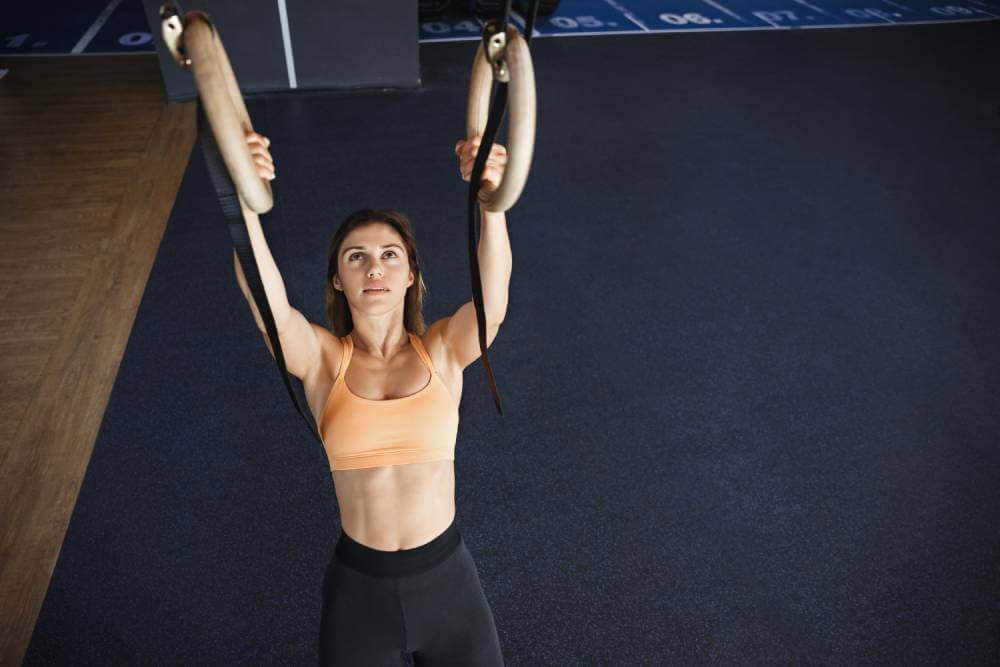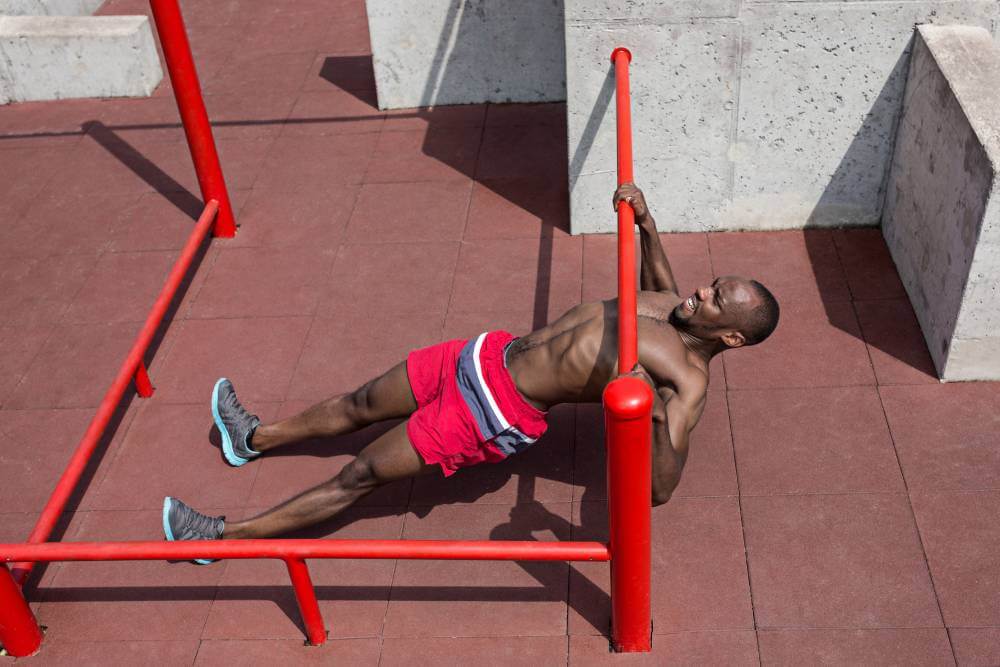The Inverted Bodyweight Row is one of the most influential and straightforward exercises for strengthening your “pull” muscles. Whether you’re working toward your first pull-up or already a pro, this exercise is essential.
What is an Inverted Bodyweight Row?

You might be familiar with the traditional barbell row, where you bend at the waist and pull a barbell toward your chest. While it’s an effective exercise, it can lead to complications if your form is off and not everyone has access to a barbell and weights.
That’s where the inverted bodyweight row comes in.
This exercise only requires a bar to lean back from and your own body weight. It eliminates the extra strain on your back that can come with a barbell row. Plus, it provides a solid core workout as well.
Think of it this way: just as the bench press represents “pushing,” the inverted row represents “pulling.”
Why the Inverted Bodyweight Row is So Great
The inverted bodyweight row is a powerhouse exercise that effectively targets all your pull muscles, making it a staple for any fitness routine. Here’s a deeper look at its benefits:
Comprehensive Muscle Engagement
When you perform an inverted row, you engage multiple muscle groups, including:
Back Muscles: This exercise works your legs, rhomboids, and traps, helping to build a strong, well-defined back.
Biceps: Your biceps are heavily involved as you pull your body toward the bar, promoting muscle growth and strength.
Forearms and Grip: By holding onto the bar, you enhance grip strength, which is crucial for many other exercises and daily activities.
Stabilizer Muscles: The inverted row also activates stabilizer muscles throughout your core and shoulders, improving overall stability and coordination.
Injury Prevention
If you’ve been focusing solely on pushing exercises like the bench press, it’s important to balance your workout routine with pulling exercises. Neglecting pull muscles can lead to imbalances that increase the risk of injury. The inverted row helps create that balance, ensuring that your muscles work harmoniously.
Building Toward Pull-Ups
For anyone aiming to achieve their first pull-up, the inverted row is an essential step in your training. It builds the strength and muscle memory needed for movement. By regularly incorporating this exercise, you’ll develop the necessary strength in your back, biceps, and core, setting a solid foundation for pull-ups.
Versatility and Accessibility
One of the great things about the inverted row is its versatility. You can perform it almost anywhere, as all you need is a sturdy bar or suspension trainer. You can easily adjust the difficulty by changing the angle of your body. For beginners, a higher bar allows for an easier angle, while lowering the bar increases the challenge as you progress.
Core Activation
In addition to working your upper body, the inverted row also engages your core. As you pull yourself up, you must maintain a straight line from your head to your heels, which strengthens your abdominal muscles and helps improve overall core stability.
How to Do an Inverted Bodyweight Row

Set the Bar Height: Begin by positioning the bar (or your rings) at waist height. Keep in mind that the lower the bar, the more challenging the movement will be.
Get Into Position: Lie on the floor underneath the bar, facing up. The bar should be set just above your reach when lying flat.
Grip the Bar: Grab the bar with an overhand grip, placing your hands slightly wider than shoulder-width apart (palms facing away from you).
Engage Your Core: Contract your abs and glutes to maintain a straight body line. Your ears, shoulders, hips, legs, and feet should form a straight line, resembling a plank position.
Pull Up: Pull your chest up toward the bar, making sure to keep your body straight. Aim to touch your chest to the bar at the top of the movement.
Lower Down: Slowly lower yourself back down while maintaining proper form, ensuring your body stays straight throughout the movement.
Modifications for Beginners
If the inverted row feels too tricky at first, don’t worry—just adjust your position:
Raise the Bar: Set the bar higher so that when you lean back, your body is at about a 45-degree angle instead of flat on the ground. This reduces the weight you have to lift.
Progress Gradually: As you build strength and/or lose weight, gradually lower the bar until you can pull yourself up from a parallel position.
Tips for Maintaining Proper Form During an Inverted Bodyweight Row
To ensure you get the most out of your inverted bodyweight rows and avoid injury, follow these key form tips:
Keep Your Body Straight: Avoid letting your butt sag. Squeeze your glutes, engage your core, and maintain a rigid line from your head to your toes throughout the movement.
Control Your Elbows: Don’t let your elbows flare out. Grip the bar a bit closer than you would for a bench press, and keep your elbows at a consistent angle relative to your body.
Pull to the Right Spot: Aim to pull the bar toward the middle of your chest. Avoid pulling it too high toward your throat or too low toward your belly button—focus on that central target!
Engage Your Abs: Keep your abdominal muscles tight for the duration of the exercise. Your body should remain in a straight line, with the only movement coming from your arms.
Activate Your Shoulder Blades: As you pull, think about drawing your shoulder blades down and back towards each other. Avoid shrugging your shoulders; instead, visualize pinching a pencil between your shoulder blades to keep them stable.
Complete the Range of Motion: Don’t shortchange the movement. Lower yourself until your arms are fully extended, and pull up until your chest touches the bar. Aim for full range to maximize effectiveness.
How to Progress with Inverted Bodyweight Rows: 6 Variations
Doorway Rows: Start by performing rows in your doorway. This variation helps you begin training your pull muscles with minimal equipment. Simply lean back against the frame and pull yourself toward it.
Towel Rows: Using a towel in your doorway allows you to lean back further, increasing the challenge. Loop the towel over the top of the door and grab both ends as you lean back and pull yourself up.
Inverted Row (High): Set the bar at a higher position to make the inverted row easier. This is a great way to practice form and build strength without too much strain.
Inverted Row (Low): As you become comfortable with the high inverted row, lower the bar to increase the difficulty. This progression will help you develop more strength and prepare for more challenging variations.
Elevated Inverted Row: Elevate your feet on a bench or step while performing the row. This adjustment increases the intensity of the exercise and engages your core even more, making it a tougher challenge.
Inverted Row (Weighted): To really ramp up the difficulty, add weight. You can use a weight vest or hold a weight plate while performing the inverted row. This variation builds significant strength in your upper body.
When Should You Do Inverted Bodyweight Rows?
Incorporate inverted bodyweight rows into your workout routine wherever you typically perform pulling exercises, such as pull-ups, pull-downs, or other rows. Here’s a sample two-day split to get you started:
Day A:
Squats
Bench Press
Inverted Rows
Dips
REST DAY: OFF
Day B:
Deadlifts
Overhead Press
Pull-Ups (or Chin-Ups)
Planks (or Floor Swipes)
REST DAY: OFF
Substitutions and Progression
If dips are too challenging on Day 1, you can easily substitute with push-ups.
If you struggle with pull-ups on Day 2, try assisted pull-ups as a modification.
For inverted rows, aim for 3 sets of 10 repetitions. If you can’t complete that yet, start with 3 sets of as many reps as you can manage and gradually work your way up to 10 reps per set.
Advanced Progression
Once you can comfortably perform 3 sets of 10, consider increasing the challenge:
Elevate your feet on a chair or bench.
Use a weighted backpack for added resistance, ensuring it hangs in front of you for stability.
Overcoming Challenges
Feeling overwhelmed is completely normal, especially when starting a strength training routine. You might have questions like:
Are you performing your exercises correctly?
Should you be lifting heavier or lighter weights?
What should you eat to support your goals?
Don’t hesitate to seek guidance from trainers or use reliable resources to ensure you’re on the right path. Remember, progress takes time, and consistency is key!
How to Do Inverted Bodyweight Rows at Home

Just because you don’t have access to a gym doesn’t mean you can’t effectively work out your back. With a little creativity and resourcefulness, you can perform inverted bodyweight rows right in your own home.
PATH ONE: Use Your Kitchen Table or Desk
Find a Suitable Table or Desk: Look for a sturdy kitchen table or desk that can support your weight without tipping over. Make sure it’s stable enough to handle the movement.
Position Yourself: Lie underneath the table so that your head and shoulders extend just above the edge. This positioning is crucial for executing the row correctly.
Grip the Edge: Reach up and grab the table edge with an overhand grip, ensuring your hands are slightly wider than shoulder-width apart.
Perform the Row: Engage your core and pull yourself up towards the table, aiming to touch your chest to the edge. Keep your body in a straight line from head to heels, avoiding any sagging at the hips.
Warning: Be cautious not to pull the table over with you. It’s important to ensure your setup is secure to prevent any accidents or damage!
PATH TWO: Use a Wooden Dowel or Pipe
Select a Strong Bar: Find a thick wooden dowel, metal pipe, or a similar sturdy object that can safely support your weight. It should be strong enough to withstand the force of your pulls.
Set Up Your Equipment: Position the dowel across two sturdy kitchen chairs, ensuring that the chairs are stable and won’t slide apart during the exercise.
Get into Position: Lie underneath the bar, grabbing it with an overhand grip. Make sure your body is aligned straight underneath the bar.
Execute the Row: Pull yourself up towards the bar while maintaining a straight body line. Aim to pull your chest to the bar, keeping your core engaged and avoiding any swinging or flailing.
Additional Tips for Home Workouts
Check Stability: Before starting your workout, always test your setup to ensure it’s secure. Give the table or bar a slight shake to confirm that it won’t move or break during your exercise.
Adjust Your Grip: Experiment with different hand placements. A wider grip can emphasize your back muscles, while a narrower grip can engage your biceps more.
Focus on Form: Pay attention to your form throughout the movement. Keep your body rigid, with your shoulders down and back, and avoid using momentum to pull yourself up.
Make It Challenging: As you build strength, consider elevating your feet on a chair or adding a weighted backpack for extra resistance. This will help you progress and continue challenging your muscles.
Be Creative: If you don’t have a pull-up bar or gymnastic rings, look for other sturdy surfaces in your home. Consider using the edge of your bed or a low table, as long as it provides the necessary support.
By implementing these tips and setups, you can successfully include inverted bodyweight rows in your strength training routine, ensuring you stay on track with your fitness goals, even at home!

